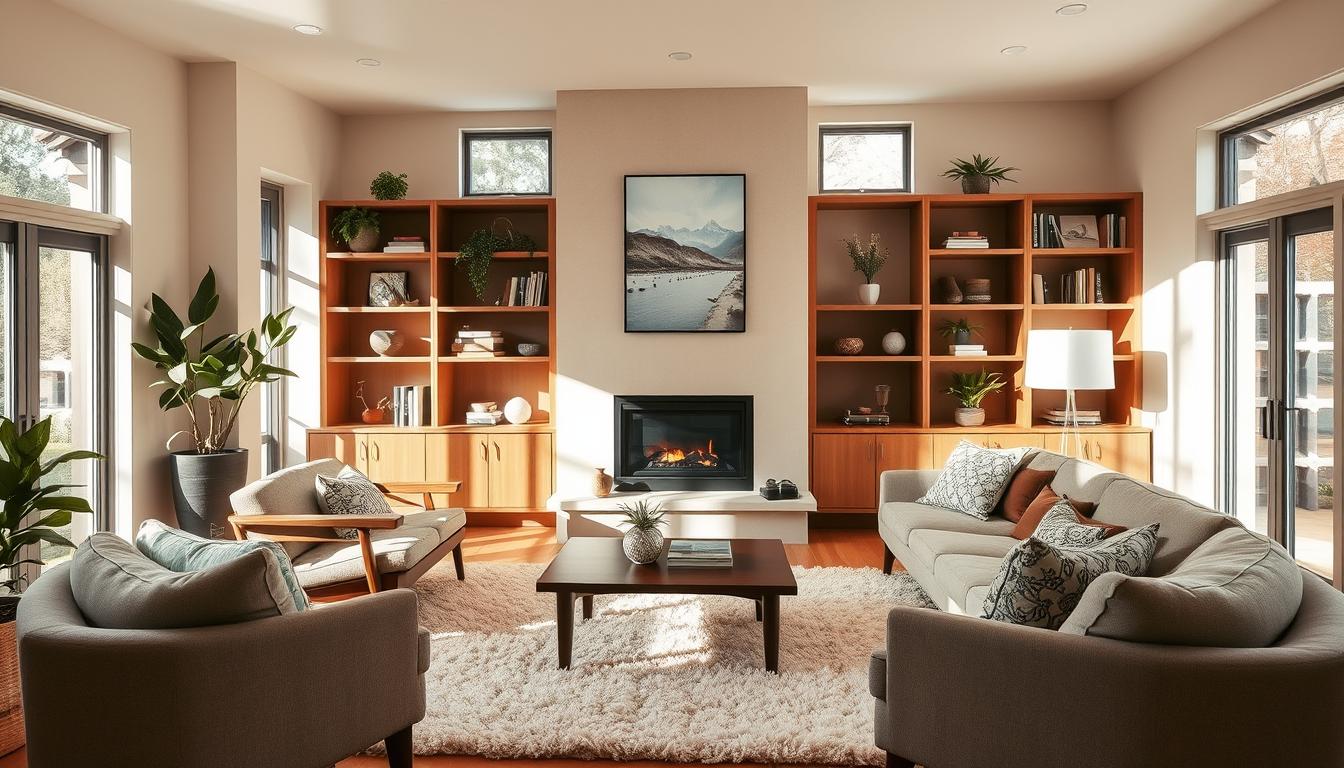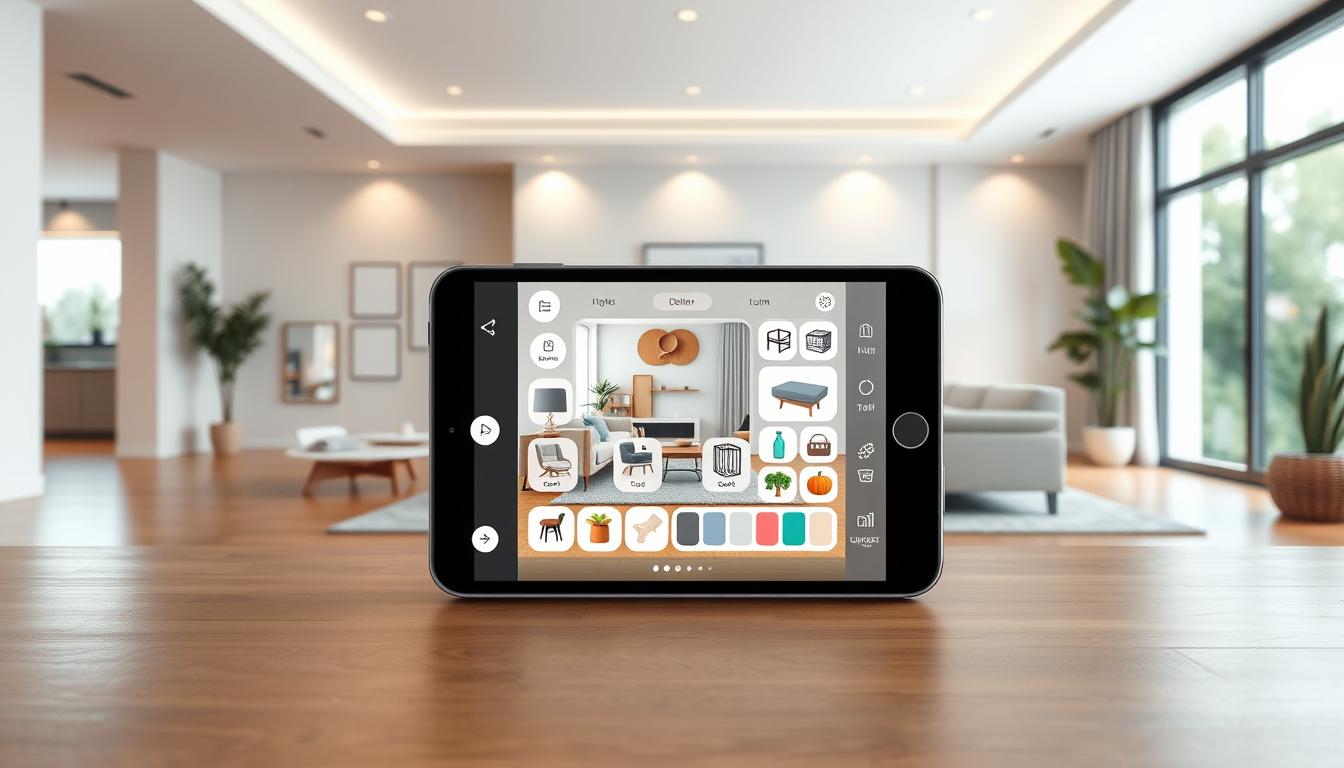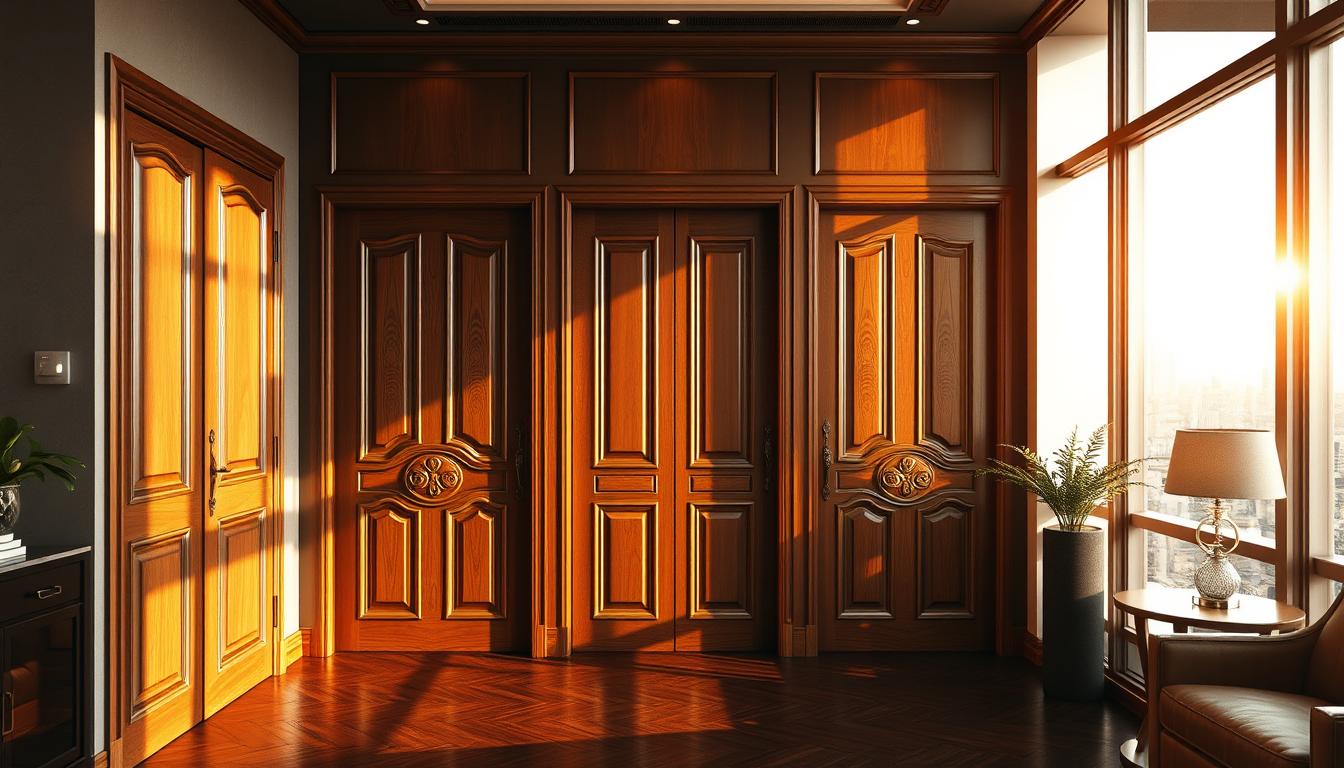We’ve worked on many rooms, from modern apartments to historic houses. We’ve learned that the secret to a great room is mixing the building’s style with the owner’s things.
Striking the right balance is key. It’s about showing off personal items and adding thoughtful pieces. This way, we make any room special and inviting.
Key Takeaways
- Balance architecture with personal style for a harmonious space.
- Curate and display personal pieces thoughtfully.
- Add thoughtful elements to enhance the room’s ambiance.
- Consider the building’s style when making decor choices.
- Elevate your space with expert interior design advice.
Understanding the Basics of Interior Design
To make your home look better, start with the basics of interior design. This includes knowing what interior design is and its main principles. Interior design is more than just picking furniture or colors. It’s about making a space that shows who you are and meets your needs.
What is Interior Design?
Interior design is a mix of art and science. It’s about understanding people’s behavior to make spaces that are both useful and beautiful. When designing modern homes, we think about natural light, colors, and furniture layout. This helps create a welcoming and balanced atmosphere.
Key Principles of Interior Design
The main principles of interior design are balance, proportion, emphasis, movement, pattern, unity, and contrast. These rules help us make spaces that look good and work well. For example, balance in a room comes from placing furniture and decorations carefully. This ensures no one thing takes over the space.
| Principle | Description | Example in Modern Home Decor |
|---|---|---|
| Balance | The arrangement of elements to create a sense of stability. | Symmetrical furniture arrangement around a central focal point. |
| Proportion | The relationship between the size of different elements. | Using oversized furniture in a large room to fill the space appropriately. |
| Emphasis | Creating a focal point in the room. | A statement piece of art or a bold-colored wall. |
The Importance of Space Planning
Space planning is key in interior design. It’s about studying how space is used in a building. Good space planning makes a room useful, efficient, and cozy. By decluttering and organizing, we make a space ready for design. This lets us display our favorite things and art in a pleasing way.
Knowing the basics of interior design helps us create homes that are both beautiful and practical. Whether you want to update one room or your whole house, these basics guide you. They help you make choices that show your style and fit with modern interior design.
Choosing the Right Color Palette
A well-chosen color palette is key to a beautiful home. It affects the mood and function of a space. When we pick colors, we’re setting the atmosphere that shows our personality and style.
Color Theory Fundamentals
Color theory is crucial for picking the right colors. It studies colors and how they work together. The color wheel is a circle of colors that shows their relationships. It helps designers find colors that look good together.
Color harmony is about colors working well together. There are many ways to do this, like using the same color in different shades. By using these methods, we can make a space that looks good and works well.
Popular Color Schemes for Homes
Popular color schemes include monochromatic, neutral, and earthy tones. A monochromatic scheme uses different shades of one color for a cohesive look. Neutral tones, like beige and gray, are versatile. Earthy tones bring warmth and coziness.
Nature is a great source of inspiration for colors. Adding natural elements like flowers or greenery can make a room feel alive. “Nothing brings a space to life like fresh flowers or greenery,” as it adds vibrancy and freshness.
“Nothing brings a space to life like fresh flowers or greenery. Whether it’s a fabulous bouquet, an urn cascading with natural foliage, a selection of house plants, or even just a few stems arranged in bud vases, flowers, and foliage always make rooms sing.”
Tips for Mixing and Matching Colors
Mixing colors can be tricky, but with some tips, you can create a unique and harmonious palette. Start with a main color and choose complementary colors. The 60-30-10 rule is helpful: 60% of the room should be the main color, 30% a secondary color, and 10% an accent color. This balance makes the space look good.
- Start with a neutral base to provide flexibility.
- Use the color wheel to identify harmonious color combinations.
- Consider the natural light in your space and how it affects the colors.
- Don’t be afraid to experiment and adjust your palette as needed.
By understanding color theory, exploring popular schemes, and mixing colors wisely, we can create a palette that reflects our style. It also makes our home more beautiful and functional.
Selecting Furniture for Your Space
To get a stylish luxury home interiors, picking the right furniture is crucial. The right pieces make your home look good, feel comfortable, and work well.
Furniture Styles to Consider
It’s important to know about different furniture styles. From modern to classic, choose what fits your taste and home’s look.
Some popular styles are:
- Modern
- Traditional
- Mid-Century Modern
- Industrial
Choosing the Right Size
Furniture that fits your room size is key. Oversized furniture can make a room feel small. Too small pieces can make it look empty.
Measure your space well. Think about how other furniture will fit too.
Placement and Arrangement Tips
Where you put furniture affects your home’s feel. Think about how people move and how the space works.
For shelves and sideboards, odd numbers and heights work well. Start with big items. Add fresh flowers, cushions, and things with stories.
For more tips on arranging furniture, check out our blog post on Mastering Furniture Arrangement for Optimal Space.
Incorporating Lighting into Your Design
Lighting is key in interior design, changing a room’s feel. It’s not just for light; it’s about mood and function. Let’s see how lighting can change your design.
The Role of Natural Light
Natural light is priceless in design. It cuts down on artificial light and boosts mood. Use windows wisely, mirrors, and treatments for the best light.
“Natural light is the most beautiful and free source of illumination,” designers say. It makes spaces bright and welcoming.
Types of Artificial Lighting
Artificial lighting has many roles. Ambient lighting sets the room’s mood. Task lighting focuses on areas like reading or cooking. Accent lighting brings out details.
- Ambient Lighting: Provides overall illumination
- Task Lighting: Focuses on specific areas for tasks
- Accent Lighting: Highlights decorative or architectural features
Layering Lighting for Ambiance
Layering lights creates a lively atmosphere. Mix ambient, task, and accent lighting for balance. Dimmers help adjust the mood.
Designers say,
“The art of lighting design lies in its ability to adapt to the changing needs of a space, making it an integral part of the interior design process.”
Using these lighting tips can make your home a showcase of your design ideas.
Adding Textiles and Accessories
Textiles and accessories can make your home special. They add color and texture. They also make your home cozy and inviting.
Window Treatments
Choosing the right window treatments is key. Layering curtains and blinds adds depth and interest. It also controls light and privacy.
For a polished look, match your window treatments to your furniture or wall colors. This makes your design cohesive and harmonious.
Defining Spaces with Rugs
Rugs help define areas in open-plan spaces. A well-placed rug anchors furniture and adds warmth.
When picking a rug, think about size, color, and texture. A rug that matches your decor adds sophistication.
The Impact of Decor on Atmosphere
Decor like cushions, throws, and wall art changes a room’s feel. Mixing textures and patterns adds interest and makes it welcoming.
To balance, mix plain with patterned or trimmed designs. This creates a lively space that shows your style.
| Decor Element | Purpose | Tips |
|---|---|---|
| Cushions and Throws | Add warmth and texture | Mix patterns and textures |
| Rugs | Define spaces and add warmth | Choose a size that fits your furniture arrangement |
| Window Treatments | Control light and add style | Layer different types for a polished look |
By adding textiles and accessories thoughtfully, you make your home beautiful and functional. These elements let you show your style and make your space unique.
Creating Functional Spaces
A well-designed home is more than just looks. It’s about making spaces that work for us. Home design interior design and modern home decor mean making spaces that are both pretty and practical.
To make these spaces, we must think about each room’s purpose. We also need to consider how people move through the home and what they need. Designing rooms that can do more than one thing is a good way to use space wisely.
Designing Multi-Functional Rooms
Multi-functional rooms are great for small homes where space is tight. By making one room do several jobs, we can use every inch of space. For instance, a room can be both a home office and a guest room. Or, a living room can also be a home gym.
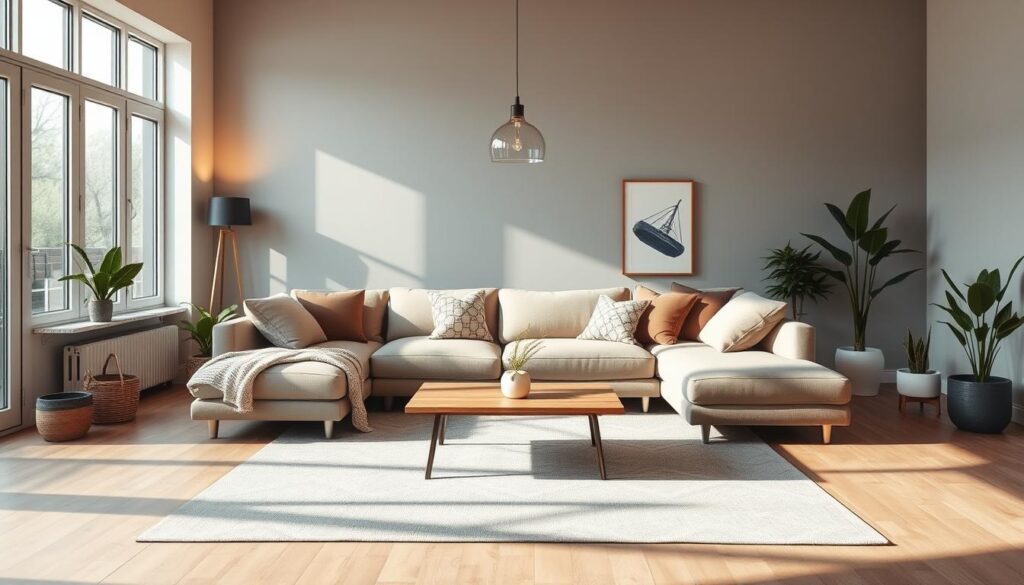
Storage Solutions for Small Spaces
Good storage is key in small spaces. We can use wall shelves, under-bed storage, and furniture that does double duty. These solutions help keep things tidy and make the space feel bigger.
“A budget is a must if you want to keep your remodel/redesign under control. Decide up front what you can spend on your project. Prioritize your expenditures into ‘must haves,’ ‘nice to haves,’ and ‘not a priority.'”
Ergonomics and Comfort in Design
Ergonomics and comfort are vital in home design. Our living spaces should be not just useful but also cozy and safe. Choosing furniture that’s both comfy and ergonomic is important. We should also design spaces that encourage good posture and prevent injuries.
By following these guidelines, we can make spaces that improve our lives.
Outdoor Spaces: Designing with Nature
Outdoor spaces are like an extension of our homes. They offer a chance to mix design with nature. As we look at modern interior design, it’s key to think about how our outdoor areas match our indoor spaces.
Designing outdoor spaces means making them feel like part of our homes. We do this by using similar designs and materials inside and outside.
Extending Your Living Area Outdoors
To make our outdoor spaces work, we need to think about their function. We might add outdoor kitchens, dining areas, or lounges that are both comfy and stylish.
For example, designer Janie Molster helped clients in Captiva Island, Florida. They wanted a house that could handle storms. Molster chose materials and designs that were both beautiful and strong.
“Designing for the outdoors requires a deep understanding of the local environment and the elements that come with it.” – Janie Molster
Choosing Outdoor Furniture
Picking the right outdoor furniture is key for welcoming spaces. We look for pieces that are stylish, durable, and weather-resistant.
- Look for materials like recycled plastic, wicker, or metal that can handle different weather.
- Choose furniture with comfy cushions and pillows that can be stored or covered when not in use.
- Go for pieces that do more than one thing, like storage ottomans or coffee tables with storage.
| Material | Durability | Maintenance |
|---|---|---|
| Recycled Plastic | High | Low |
| Wicker | Medium | Medium |
| Metal | High | Medium |
Landscaping Ideas for Curb Appeal
Landscaping is crucial for our home’s curb appeal. By using natural elements and smart design, we can make a great first impression.
Some popular trends include using native plants, creating layered landscapes, and adding outdoor lighting. These highlight our home’s best features.
By following these tips and thinking about our outdoor spaces, we can make beautiful, useful areas. These areas will enhance our homes and show off our personal style.
Sustainable Interior Design Practices
Exploring interior design, we must think about our environmental impact. Sustainable design is key for homes that are both fancy and green.
Materials play a big role in sustainable design. Eco-friendly materials are sourced sustainably, recycled, or have low environmental impact. For example, using reclaimed wood for furniture or flooring adds character and saves trees.
Eco-Friendly Materials
Right materials make a big difference. Here are some:
- Bamboo flooring, which is highly renewable
- Recycled glass countertops, which reduce waste
- Sustainably sourced hardwood, which preserves forests
Janie Molster used performance fabrics for her sofas. This keeps them stylish and clean for years. It’s good for the planet and looks great.
Energy Efficiency in Design
Energy efficiency is vital in sustainable design. It’s not just about using efficient appliances. It’s also about designing for natural light and less artificial light. LED lighting is a top choice for saving energy.
Improving energy efficiency includes:
- Installing skylights or larger windows for more natural light
- Using smart home devices to control lighting and temperature
- Choosing appliances with high energy efficiency ratings
Creating a Sustainable Home Environment
A sustainable home is more than materials and energy. It’s about well-being and less environmental impact. This means using non-toxic paints, improving air quality, and adding plants.
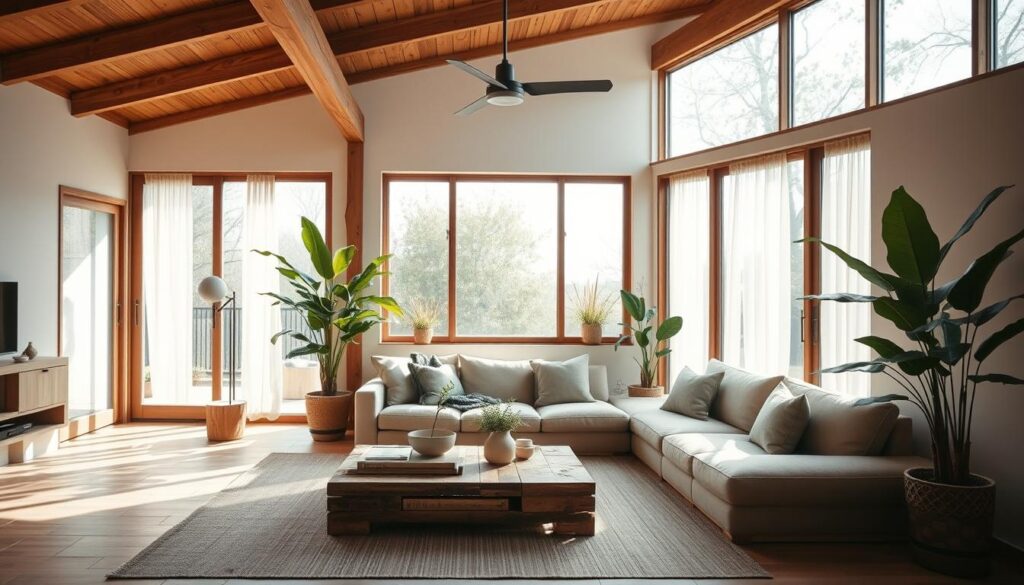
By using these sustainable practices, we make homes that are beautiful, luxurious, and green. As we aim for a greener future, these practices will be crucial in interior design.
Incorporating Technology into Home Design
Technology is changing how we live in our homes. It’s key to add it in a way that makes our homes better to use and look at. As tech gets better, our homes should too.
Smart Home Devices and Their Benefits
Smart home devices lead the way in home tech. They include voice assistants, smart lights, and more. They make our lives easier, save energy, and keep our homes safe.
Some top smart home devices are:
- Voice-controlled assistants like Amazon Alexa or Google Home
- Smart lighting systems that adjust based on the time of day or occupancy
- Automated window treatments for optimal natural light and temperature control
- Smart security cameras and door locks for enhanced security
Integrating Technology Seamlessly
To get the most from smart home tech, it must fit well with your home’s design. Choose devices that match your home’s look. This makes them blend in and look good.
Architect J.E. Schram’s kitchen remodel shows how to do it right. He made the space feel bigger by rearranging it. He added more counter space and cabinets, making it more useful and stylish.
Future Trends in Smart Home Design
Smart home design is getting even better. We’ll see more AI, better energy use, and easier controls. The goal is to make homes that are smart, green, and meet our needs.
| Trend | Description | Benefit |
|---|---|---|
| Artificial Intelligence Integration | AI systems that learn and adapt to homeowner habits | Enhanced convenience and personalized experience |
| Energy Efficiency Enhancements | Advanced systems for reducing energy consumption | Lower utility bills and reduced environmental impact |
| Intuitive Control Systems | Simplified interfaces for managing smart home devices | Easier management of home technology |
By following these trends, we can make homes that are not just pretty and useful. They’ll also be smart and good for the planet.
Personalizing Your Home Design
Adding personal touches to your home makes it warm and inviting. A home should show off the personality and style of its owners. This makes it truly unique and special.
Reflecting Your Personal Style
Your personal style is key to your home’s design. It makes your space stand out and feel like your own. Think about adding things you love, like favorite colors or textures.
If you love contemporary interior design styles, add sleek lines and modern tech. For a traditional look, choose classic furniture and timeless decor.
“The best rooms have something to say about the people who live in them.”
Infusing Cultural Elements
Cultural elements add depth and character to your home. Adding a piece of artwork or a traditional textile makes your space more meaningful.
Designer Breegan Jane used a Moroccan fountain in a guest bathroom. It provided “auditory privacy” and made the space cozy. This shows how cultural elements are important in design.
The Importance of Personal Touches
Personal touches make a house feel like a home. They can be family photos, heirlooms, or personal mementos. These add warmth and connection.
- Display personal items such as artwork, collectibles, or sentimental objects.
- Incorporate meaningful colors or textures that reflect your personality.
- Create a gallery wall featuring family photos or favorite quotes.
By adding these personal touches, you create a home that is beautiful and meaningful. It shows off your personality.
Budgeting for Your Interior Design Project
As we wrap up our look at interior design, it’s key to think about the money side. Budgeting is crucial to make sure your project is done on time and within your budget.
Assessing Costs and Contractor Bids
When starting an interior design project, getting bids from contractors is important. We suggest getting at least three bids to see prices and services. This helps you compare costs and also the quality and management skills of contractors.
You can add top home design trends and luxury touches without spending too much. By focusing on what you need, choosing affordable design options, and spending on quality where it counts, you can make a beautiful and useful space. This space will show off your personal style.

